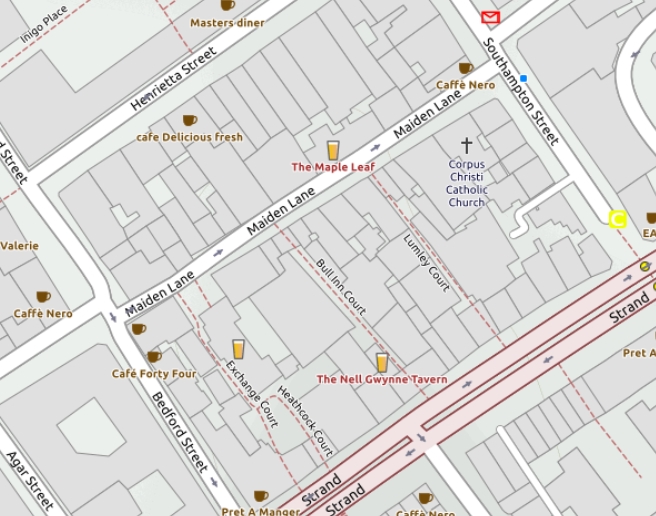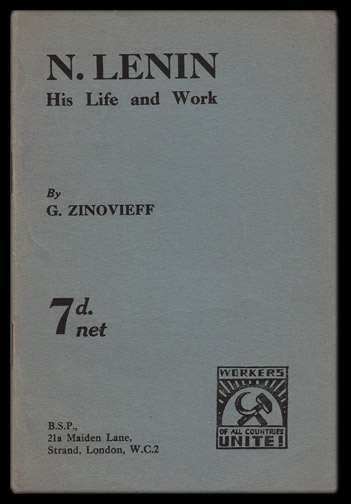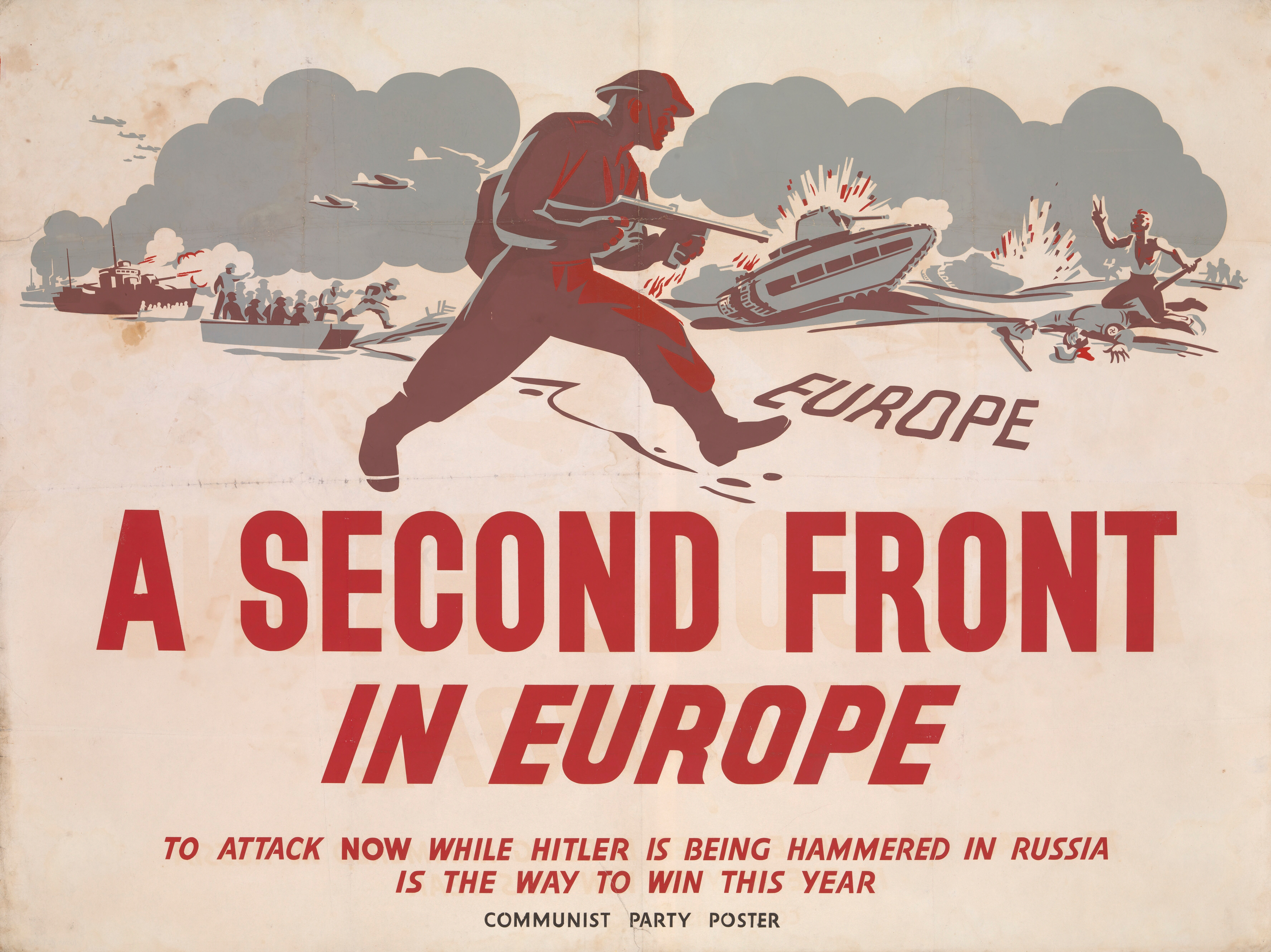|
Maiden Lane, Covent Garden
Maiden Lane is a street in Covent Garden, London, that runs from Bedford Street in the west to Southampton Street in the east. The painter J. M. W. Turner was born in the street in 1775. History The street is based on an ancient track that ran through the Convent Garden to St. Martin's Lane. According to Isaac D'Israeli, the street was named after a statue of the Virgin Mary that once stood in the street. It was built up from 1631 to 1728. In 1727–28, Voltaire stayed at the White Wig Inn while he was exiled from Paris. The painter J.M.W. Turner was born above his father's barber shop at number 21 in 1775. The British Socialist Party established their offices at 21a Maiden Lane. This premises was taken over by the Communist Party of Great Britain during their first year of existence. Buildings Corpus Christi Roman Catholic Church is located in the street. The restaurant Rules is at No. 34. Europe's first recording studio was opened here in 1898. See also *Maiden Lane ... [...More Info...] [...Related Items...] OR: [Wikipedia] [Google] [Baidu] |
Corpus Christi R
Corpus is Latin for "body". It may refer to: Linguistics * Text corpus, in linguistics, a large and structured set of texts * Speech corpus, in linguistics, a large set of speech audio files * Corpus linguistics, a branch of linguistics Music * ''Corpus'' (album), by Sebastian Santa Maria * Corpus Delicti (band), also known simply as Corpus Medicine * Corpus callosum, a structure in the brain * Corpus cavernosum (other), a pair of structures in human genitals * Corpus luteum, a temporary endocrine structure in mammals * Corpus gastricum, the Latin term referring to the body of the stomach * Corpus alienum, a foreign object originating outside the body * Corpus albicans * Corpora amylacea * Corpora arenacea Other uses * ''Corpus'' (Bernini), a 1650 sculpture of Christ by Gian Lorenzo Bernini * Corpus (museum), a human body themed museum in the Netherlands * Corpus Clock, a large sculptural clock * Corpus (dance troupe), a Canadian dance troupe * Corpus (typography) ... [...More Info...] [...Related Items...] OR: [Wikipedia] [Google] [Baidu] |
Covent Garden
Covent Garden is a district in London, on the eastern fringes of the West End, between St Martin's Lane and Drury Lane. It is associated with the former fruit-and-vegetable market in the central square, now a popular shopping and tourist site, and with the Royal Opera House, itself known as "Covent Garden". The district is divided by the main thoroughfare of Long Acre, north of which is given over to independent shops centred on Neal's Yard and Seven Dials, while the south contains the central square with its street performers and most of the historical buildings, theatres and entertainment facilities, including the London Transport Museum and the Theatre Royal, Drury Lane. The area was fields until briefly settled in the 7th century when it became the heart of the Anglo-Saxon trading town of Lundenwic, then abandoned at the end of the 9th century after which it returned to fields. By 1200 part of it had been walled off by the Abbot of Westminster Abbey for use as arable l ... [...More Info...] [...Related Items...] OR: [Wikipedia] [Google] [Baidu] |
Bedford Street
The Bedford Estate is an estate in central London owned by the Russell family, which holds the peerage title of Duke of Bedford. The estate was originally based in Covent Garden, then stretched to include Bloomsbury in 1669.History , The Bedford Estates, Bloomsbury, London, UK. The Covent Garden property was sold for £2 million in 1913 by , to the MP and land speculator , who sold his option to the [...More Info...] [...Related Items...] OR: [Wikipedia] [Google] [Baidu] |
Southampton Street, London
Southampton Street is a street in central London, running north from the Strand to Covent Garden Market. There are restaurants in the street such as Bistro 1 and Wagamama. There are also shops such as The North Face outdoor clothing shop. History and people The street, like Southampton Row in Bloomsbury to the north, is named after Sir Thomas Wriothesley, 4th Earl of Southampton (1607–1667). It used to be in the district of Bloomsbury, but is now officially in Westminster. Ambrose Godfrey (1660–1741), a German-born chemist, inventor of the fire extinguisher, and a collaborator of Robert Boyle, lived and had a laboratory and pharmacy in the street from 1706 until his death. A green plaque installed by the City of Westminster marks the site on the west side of the street at No. 31. John Ashburnham, 1st Baron Ashburnham, a landowner and politician, died at Southampton Street on 21 January 1710, aged 54. Charles Combe, the physician and numismatist, was born on 23 Septem ... [...More Info...] [...Related Items...] OR: [Wikipedia] [Google] [Baidu] |
Maiden Lane, Covent Garden
Maiden Lane is a street in Covent Garden, London, that runs from Bedford Street in the west to Southampton Street in the east. The painter J. M. W. Turner was born in the street in 1775. History The street is based on an ancient track that ran through the Convent Garden to St. Martin's Lane. According to Isaac D'Israeli, the street was named after a statue of the Virgin Mary that once stood in the street. It was built up from 1631 to 1728. In 1727–28, Voltaire stayed at the White Wig Inn while he was exiled from Paris. The painter J.M.W. Turner was born above his father's barber shop at number 21 in 1775. The British Socialist Party established their offices at 21a Maiden Lane. This premises was taken over by the Communist Party of Great Britain during their first year of existence. Buildings Corpus Christi Roman Catholic Church is located in the street. The restaurant Rules is at No. 34. Europe's first recording studio was opened here in 1898. See also *Maiden Lane ... [...More Info...] [...Related Items...] OR: [Wikipedia] [Google] [Baidu] |
Isaac D'Israeli
Isaac D'Israeli (11 May 1766 – 19 January 1848) was a British writer, scholar and the father of British Prime Minister Benjamin Disraeli. He is best known for his essays and his associations with other men of letters. Life and career Isaac was born in Enfield, Middlesex, England, the only child of Benjamin D'Israeli (1730–1816), a Sephardic Jewish merchant who had immigrated from Cento, Italy, in 1748, and his second wife, Sarah Syprut de Gabay Villa Real (1742/3–1825). Isaac received much of his education in Leiden. At the age of 16, he began his literary career with some verses addressed to Samuel Johnson. He became a frequent guest at the table of the publisher John Murray and became one of the noted bibliophiles of the time. In 1797 D'Israeli published ''Vaurien,'' a romantic novel set in radical circles following the French Revolution. Conservative commentators praised the book for its mockery of radicals in England and depiction of Vaurien, who has come from France ... [...More Info...] [...Related Items...] OR: [Wikipedia] [Google] [Baidu] |
Voltaire
François-Marie Arouet (; 21 November 169430 May 1778) was a French Age of Enlightenment, Enlightenment writer, historian, and philosopher. Known by his ''Pen name, nom de plume'' M. de Voltaire (; also ; ), he was famous for his wit, and his criticism of Christianity—especially Criticism of the Catholic Church, of the Roman Catholic Church—and of slavery. Voltaire was an advocate of freedom of speech, freedom of religion, and separation of church and state. Voltaire was a versatile and prolific writer, producing works in almost every literary form, including stageplay, plays, poems, novels, essays, histories, and scientific Exposition (narrative), expositions. He wrote more than 20,000 letters and 2,000 books and pamphlets. Voltaire was one of the first authors to become renowned and commercially successful internationally. He was an outspoken advocate of civil liberties and was at constant risk from the strict censorship laws of the Catholic French monarchy. His polemics ... [...More Info...] [...Related Items...] OR: [Wikipedia] [Google] [Baidu] |
Paris
Paris () is the capital and most populous city of France, with an estimated population of 2,165,423 residents in 2019 in an area of more than 105 km² (41 sq mi), making it the 30th most densely populated city in the world in 2020. Since the 17th century, Paris has been one of the world's major centres of finance, diplomacy, commerce, fashion, gastronomy, and science. For its leading role in the arts and sciences, as well as its very early system of street lighting, in the 19th century it became known as "the City of Light". Like London, prior to the Second World War, it was also sometimes called the capital of the world. The City of Paris is the centre of the Île-de-France region, or Paris Region, with an estimated population of 12,262,544 in 2019, or about 19% of the population of France, making the region France's primate city. The Paris Region had a GDP of €739 billion ($743 billion) in 2019, which is the highest in Europe. According to the Economist Intelli ... [...More Info...] [...Related Items...] OR: [Wikipedia] [Google] [Baidu] |
British Socialist Party
The British Socialist Party (BSP) was a Marxist political organisation established in Great Britain in 1911. Following a protracted period of factional struggle, in 1916 the party's anti-war forces gained decisive control of the party and saw the defection of its pro-war right wing. After the victory of the Bolshevik Revolution in Russia at the end of 1917 and the termination of the First World War the following year, the BSP emerged as an explicitly revolutionary socialist organisation. It negotiated with other radical groups in an effort to establish a unified communist organisation, an effort which culminated in August 1920 with the establishment of the Communist Party of Great Britain. The youth organisation the Young Socialist League was affiliated with the party. Organizational history Formative period (1911–1914) The founding conference which established the British Socialist Party was called by the Social Democratic Party (SDP), a group best remembered to history by i ... [...More Info...] [...Related Items...] OR: [Wikipedia] [Google] [Baidu] |
Communist Party Of Great Britain
The Communist Party of Great Britain (CPGB) was the largest communist organisation in Britain and was founded in 1920 through a merger of several smaller Marxist groups. Many miners joined the CPGB in the 1926 general strike. In 1930, the CPGB founded the ''Daily Worker'' (renamed the ''Morning Star'' in 1966). In 1936, members of the party were present at the Battle of Cable Street, helping organise resistance against the British Union of Fascists. In the Spanish Civil War the CPGB worked with the USSR to create the British Battalion of the International Brigades, which party activist Bill Alexander commanded. In World War II, the CPGB mirrored the Soviet position, opposing or supporting the war in line with the involvement of the USSR. By the end of World War II, CPGB membership had nearly tripled and the party reached the height of its popularity. Many key CPGB members became leaders of Britain's trade union movement, including most notably Jessie Eden, Abraham Lazarus ... [...More Info...] [...Related Items...] OR: [Wikipedia] [Google] [Baidu] |
Corpus Christi Roman Catholic Church, Maiden Lane
Corpus Christi Roman Catholic Church, Maiden Lane, is a Roman Catholic church in Maiden Lane, Covent Garden, in the Westminster City Council area of London, England. The church building, in Early English Gothic style, is grade II listed and was designed by F. H. Pownall; it was “specifically devoted to the adoration of the Blessed Sacrament.” History The site was leased to the parish by the Duke of Bedford with the condition that the church should cost no less than £6,000; it actually cost £8,000. The foundation stone was laid in 1873, with the internal floor level three feet below pavement level to avoid the building being too tall. It was opened in 1874 by Cardinal Henry Manning, at that time the Archbishop of Westminster, and dedicated to Corpus Christi "as an act of reparation for the indignities offered to the Blessed Sacrament in this country in the sixteenth century and since". It was not consecrated until 1956 when the debt was finally cleared. One of the ea ... [...More Info...] [...Related Items...] OR: [Wikipedia] [Google] [Baidu] |
Rules (restaurant)
Rules is a London restaurant on Maiden Lane in Covent Garden. Rules was founded in 1798 by Thomas Rule, and describes itself as London's oldest restaurant. History Rules was opened by Thomas Rule in 1798, primarily as an oyster bar but served, and continues to serve, traditional British cuisine. Rules specialises in game and has its own estate, the Lartington Estate, in Teesdale. Thomas Rule was later committed to a psychiatric hospital for murder of his wife Isabella and daughter Elsie Rule The restaurant stayed in the Rule family until World War I, when Charles Rule swapped businesses with Thomas Bell. Bell's daughter subsequently sold the restaurant to the current owner John Mayhew in 1984. Efforts have been made to carefully preserve the original features in the main restaurant and in the cocktail bar. The walls are decorated with a series of sketches, oil paintings and cartoons which have been collected throughout its history. A number of its artworks depict thea ... [...More Info...] [...Related Items...] OR: [Wikipedia] [Google] [Baidu] |








